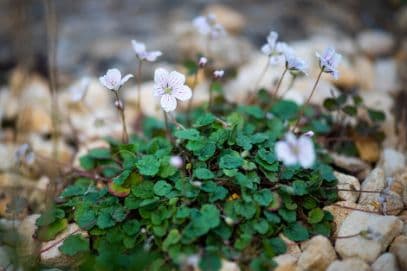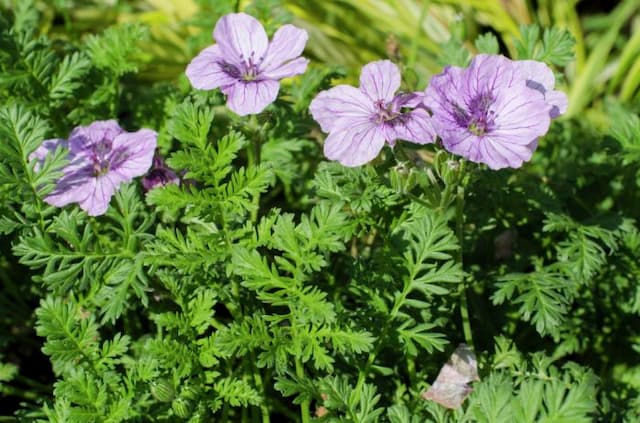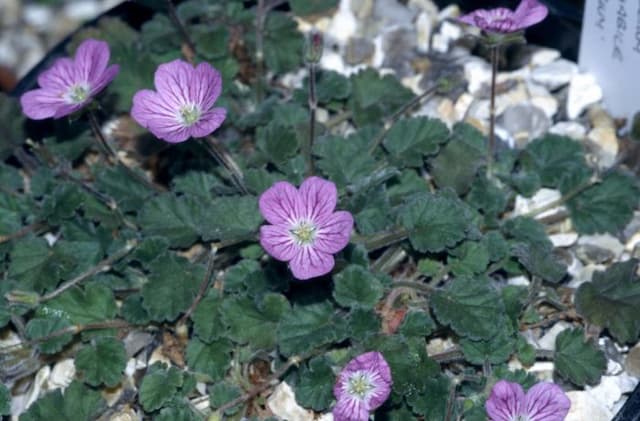Cranesbill Geranium gracile 'Blanche'

ABOUT
Geranium gracile 'Blanche' features a delicate appearance with a profusion of small, round to slightly elongated leaves that create a dense, lush foliage. The leaves are usually a deep green color, providing a rich background for the flowers. The blooms are the most striking feature of this plant, with each flower presenting a simple yet elegant form. They typically consist of five rounded petals that can best be described as pure white, sometimes with subtle veining or a hint of pale pink at their base. The flowers appear in clusters, creating a lovely contrast against the green foliage, giving the plant a soft, frothy look. The overall effect is one of grace and subtlety, as 'Blanche' adds a peaceful serenity to any garden space it inhabits.
About this plant
 Names
NamesFamily
Geraniaceae
Synonyms
Slender Geranium, Graceful Cranesbill
Common names
Geranium gracile 'Blanche'.
 Toxicity
ToxicityTo humans
The plant commonly known as Geranium is not considered highly toxic to humans. However, ingestion of Geranium species can sometimes cause mild symptoms, such as diarrhea, vomiting, or an upset stomach. Contact with the skin may sometimes cause dermatitis in sensitive individuals. In general, it is advisable to avoid ingesting any part of the Geranium due to the potential for gastrointestinal discomfort.
To pets
Geraniums are considered to be mildly toxic to pets, such as dogs and cats. If a pet ingests a part of a Geranium, it could exhibit symptoms of poisoning which may include vomiting, anorexia, depression, and dermatitis. While severe reactions are not common, it is still best to prevent pets from ingesting any parts of the plant and to monitor for any signs of illness if ingestion occurs.
 Characteristics
CharacteristicsLife cycle
Perennials
Foliage type
Deciduous
Color of leaves
Green
Flower color
White
Height
1-2 feet (30-60 cm)
Spread
1-2 feet (30-60 cm)
Plant type
Herb
Hardiness zones
5
Native area
Mexico
Benefits
 General Benefits
General Benefits- Easy to Grow: Geranium gracile 'Blanche' is known for being easy to maintain, making it suitable for beginner gardeners.
- Attractive Flowers: The plant produces beautiful flowers that can enhance the aesthetic appeal of gardens and indoor spaces.
- Drought Tolerant: It has good drought tolerance once established, therefore, it's a good choice for water-wise gardens in dryer regions.
- Pest Resistance: They are generally resistant to common garden pests, reducing the need for chemical treatments.
- Long Blooming Period: Geraniums often have a long flowering season, providing color in the garden for an extended period.
- Versatile Uses: Can be used in a variety of garden settings such as borders, containers, and as ground covers.
- Attracts Pollinators: The flowers can attract bees and butterflies, promoting pollination in the garden.
- Diverse Range of Conditions: Geraniums can thrive in a range of soil types and varying amounts of sunlight, from full sun to partial shade.
- Low Maintenance: Once established, they require minimal care, only needing occasional deadheading and watering during prolonged dry spells.
- Seasonal Interest: It can provide seasonal interest with its foliage even when not in bloom, especially in varieties with variegated or colorful leaves.
 Medical Properties
Medical PropertiesThis plant is not used for medical purposes.
 Air-purifying Qualities
Air-purifying QualitiesThis plant is not specifically known for air purifying qualities.
 Other Uses
Other Uses- Botanical Illustration Subject: Geraniums, including Geranium gracile 'Blanche', are often used as subjects for botanical illustrations due to their intricate petal patterns and diverse color palette.
- Photography Projects: The striking appearance of Geraniums makes them ideal subjects for macro photography, highlighting the detailed structures of their blooms and foliage.
- Natural Fabric Dyes: The petals of Geraniums can be used to produce a range of natural dyes for coloring fabrics, offering hues from subtle pinks to rich purples depending on the mordant used.
- Artistic Inspiration: Artists may draw inspiration from the form and color of Geraniums to create paintings, sculptures, and other forms of art that capture the plant’s beauty.
- Culinary Garnishes: Edible varieties of Geraniums can be used as decorative garnishes to add a touch of elegance to dishes and desserts.
- Handmade Paper: Geranium petals and leaves can be incorporated into handmade paper, adding texture and botanical elements to the finished product.
- Educational Tool: In schools, Geraniums can be used to teach children about plant biology, life cycles, and how to care for living organisms.
- Floral Arrangements: Geraniums, with their bold flowers and attractive foliage, can be used in floral arrangements and bouquets for special occasions.
- Scented Potpourris: The leaves of scented Geranium varieties can be dried and added to potpourris to provide a pleasant fragrance to indoor spaces.
- Horticultural Therapy: Interacting with and caring for Geraniums can be a part of horticultural therapy programs, promoting well-being and relaxation.
Interesting Facts
 Feng Shui
Feng ShuiThe Geranium is not used in Feng Shui practice.
 Zodiac Sign Compitability
Zodiac Sign CompitabilityThe Geranium is not used in astrology practice.
 Plant Symbolism
Plant Symbolism- Unity and Friendship: Geraniums often represent unity or true friendship due to their long-lasting nature and the way their clusters of flowers symbolize togetherness.
- Good Health: In some traditions, geraniums are thought to symbolize good health, possibly because they have been used in folk medicine.
- Folly or Stupidity: In the language of flowers, geraniums sometimes represent folly or stupidity, perhaps because of the way the foliage can take on unexpected shapes.
- Peace: The calming scent and gentle appearance of geraniums can symbolize peace and tranquility in a home or garden.
- Ingenuity: The adaptability and resilience of geranium plants can make them a symbol for ingenuity or resourcefulness.
 Water
WaterGeraniums require consistent watering to maintain moist but not waterlogged soil. For Geranium gracile 'Blanche', water thoroughly when the top inch of soil feels dry to the touch. Depending on environmental conditions such as temperature and humidity, this may mean watering once or twice a week. Use about one gallon of water per plant each time you water, making sure to soak the soil thoroughly without leaving the plant in standing water. Adjust the watering schedule during hot, dry periods or when the plant is in active growth, as it may require more frequent watering.
 Light
LightGeranium gracile 'Blanche', commonly known as hardy geranium, thrives best in full sun to partial shade. An optimal spot would be somewhere it can receive at least 4 to 6 hours of sunlight per day. It can also perform well in light, dappled shade, particularly in hotter climates where the afternoon sun can be intense.
 Temperature
TemperatureHardy geraniums like Geranium gracile 'Blanche' prefer moderate temperatures and can generally tolerate a range from 40°F to 75°F. They can survive briefly in temperatures as low as 20°F, but frosts can damage the plant. Ideally, maintain an environment where the temperature does not regularly drop below 50°F or exceed 75°F for optimal growth.
 Pruning
PruningPrune Geranium gracile 'Blanche' to encourage bushy growth and remove spent flowers, which promotes further blooming. Pruning can be done in early spring or after the plant has finished blooming. Cut back the plant by one-third to one-half, and always use clean, sharp pruning shears. Pruning every couple of years helps to rejuvenate older plants.
 Cleaning
CleaningAs needed
 Soil
SoilHardy Geraniums prefer well-draining soil with even moisture, and for 'Blanche', a mix of peat, perlite, and garden loam works well. Aim for a slightly acidic to neutral pH of about 5.8 to 7.
 Repotting
RepottingHardy Geranium 'Blanche' should be repotted every 2 to 3 years or when it outgrows its current container to refresh the soil and encourage growth.
 Humidity & Misting
Humidity & MistingHardy Geranium 'Blanche' thrives best in average humidity levels, similar to those found in most homes; no special humidity adjustments are needed.
 Suitable locations
Suitable locationsIndoor
Place in bright, indirect light and water when topsoil feels dry.
Outdoor
Full sun to part shade, well-draining soil, water when 1-inch soil is dry.
Hardiness zone
4-8 USDA
 Life cycle
Life cycleGeranium gracile 'Blanche', commonly known as Hardy Geranium, starts its life cycle as a seed, which germinates in spring when temperatures and soil conditions are favorable. After germination, the seedling grows and develops a root system and foliage through the vegetative stage. As the plant matures, it enters the flowering stage, typically in late spring to early summer, producing delicate blossoms that attract pollinators. Following pollination, the flowers develop into fruiting bodies containing seeds, completing the reproductive phase. The plant may die back to the ground in colder climates during the autumn and winter months but can re-emerge from its rootstock or overwintering buds when the weather warms. Hardy Geraniums are perennials, so this cycle of growth, flowering, seed production, and dormancy repeats annually for several years.
 Propogation
PropogationPropogation time
Spring-Early Summer
Geranium, specifically the variety Geranium gracile 'Blanche', is most commonly propagated through cuttings. This method is popular due to its simplicity and efficiency. The best time to take cuttings is in late spring or early summer when the plant is actively growing. To propagate, select healthy, non-flowering stems and cut a 4 to 6-inch (10 to 15 cm) piece just below a node. Remove the leaves from the bottom half of the cutting and dip the cut end into rooting hormone. Then, plant the cutting in a mix of peat and perlite or in well-draining potting soil. Ensure adequate moisture and warmth, and the cutting should root in a few weeks, after which it can be transplanted to a more permanent location.




![Cranesbill [Blue Sunrise]](/_next/image?url=https%3A%2F%2Fplants-admin.emdemapps.com%2Fimages%2Fplants%2F%2Fimages%2F604b638d45948.png&w=640&q=75)




